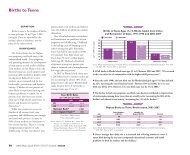2010 Rhode Island Kids Count Factbook
2010 Rhode Island Kids Count Factbook
2010 Rhode Island Kids Count Factbook
Create successful ePaper yourself
Turn your PDF publications into a flip-book with our unique Google optimized e-Paper software.
Methodology<br />
The <strong>2010</strong> <strong>Rhode</strong> <strong>Island</strong> <strong>Kids</strong> <strong>Count</strong><br />
<strong>Factbook</strong> examines 67 indicators in five<br />
areas that affect the lives of children:<br />
Family and Community, Economic<br />
Well-Being, Health, Safety and<br />
Education. The information on each<br />
indicator is organized as follows:<br />
◆ Definition: A description of the<br />
indicator and what it measures.<br />
◆ Significance: The relationship of the<br />
indicator to child and family well-being.<br />
◆ National Rank and New England<br />
Rank: For those indicators that are<br />
included in the Annie E. Casey<br />
Foundation’s KIDS COUNT<br />
publications, the <strong>Factbook</strong> highlights<br />
<strong>Rhode</strong> <strong>Island</strong>’s rank among the 50 states,<br />
as well as trends since 2000. The New<br />
England Rank highlights <strong>Rhode</strong> <strong>Island</strong>’s<br />
rank among the six New England states –<br />
Connecticut, Maine, Massachusetts, New<br />
Hampshire, <strong>Rhode</strong> <strong>Island</strong>, and Vermont.<br />
◆ Sidebars: Current state and national<br />
data and information related to the<br />
indicator.<br />
◆ City/Town Tables: Data presented for<br />
each of <strong>Rhode</strong> <strong>Island</strong>’s cities and towns,<br />
the state as a whole and the core cities.<br />
◆ Core Cities Data: The core cities<br />
are the six <strong>Rhode</strong> <strong>Island</strong> communities<br />
in which more than 15% of the<br />
children live below the poverty<br />
threshold according to the 2000<br />
Census. They include: Central Falls,<br />
Newport, Pawtucket, Providence,<br />
West Warwick and Woonsocket.<br />
◆ Most Recent Available Data: The<br />
<strong>2010</strong> <strong>Factbook</strong> uses the most current,<br />
reliable data available for each indicator.<br />
Numbers<br />
The most direct measure of the scope<br />
of a problem is the count of the number<br />
of events of concern during a specified<br />
time period - e.g., the number of<br />
child deaths between 2004 and 2008.<br />
Numbers are important in assessing the<br />
scope of the problem and in estimating<br />
the resources required to address a<br />
problem. Numbers are not useful to<br />
compare the severity of the problem<br />
from one geographic area to another or<br />
to compare the extent of the problem in<br />
<strong>Rhode</strong> <strong>Island</strong> with national standards.<br />
For example, a state with more children<br />
might have more low birthweight infants<br />
due to the larger number of total births,<br />
not due to an increased likelihood of<br />
being born with low birthweight.<br />
Rates and Percentages<br />
A rate is a measure of the frequency<br />
of an event - e.g., out of every 1,000<br />
live births, how many infants will be<br />
breastfed. A percentage is another<br />
measure of frequency - e.g., out of<br />
every 100 births, how many will be<br />
born low birthweight. Rates and<br />
percentages take into account the total<br />
population of children eligible for an<br />
event. They are useful in comparing the<br />
severity of the problem from one<br />
geographic area to another, to compare<br />
with state or national standards or to look<br />
at trends over time.<br />
Sources of Data and<br />
Methodology for Calculating<br />
Rates and Percentages<br />
For each indicator, the source of<br />
information for the actual number of<br />
events of interest (the numerator) are<br />
identified within the Source of<br />
Data/Methodology section next to the<br />
table for that indicator. For each<br />
indicator that uses a rate or a percent,<br />
the source of data for the total number<br />
of children eligible for the indicator of<br />
interest (the denominator) is also noted<br />
within the Source of Data/Methodology<br />
section. Rates and percentages are not<br />
calculated for cities and towns with<br />
small denominators (less than 500 for<br />
delayed prenatal care, low birthweight<br />
infants, and infant mortality rates and<br />
less than 100 for births to teens). Rates<br />
and percentages for small denominators<br />
are statistically unreliable. “NA” is used<br />
in the indicator table when this occurs.<br />
In the indicator for child deaths and<br />
teen deaths, and other indicators in<br />
which the indicator events are rare, city<br />
and town rates are not calculated, as<br />
small numbers make these rates<br />
statistically unreliable.<br />
Census Data<br />
There are four sources of U.S. Census<br />
Bureau data used in the <strong>Factbook</strong>: Census<br />
2000, the Current Population Survey,<br />
Population Estimates and the American<br />
Community Survey. In all city/town<br />
tables that require population statistics,<br />
data is from Census 2000 as is stated in<br />
Source sections. Throughout the text<br />
portions of each indicator, all four sources<br />
are used and the relevant citations provide<br />
clarification on which source data come<br />
from. In instances where Census 2000<br />
data is used in the denominator, caution<br />
should be taken when comparing new<br />
rates with those for past years, as actual<br />
population numbers may have changed.<br />
Whenever possible, Census data are<br />
updated using the most recent data from<br />
the American Community Survey<br />
conducted by the U.S. Census Bureau.<br />
Methodology for<br />
Children with Lead Poisoning<br />
The number of children confirmed<br />
positive for lead levels > 10 mcg/dL are<br />
based on venous tests and confirmed<br />
capillary tests only. The highest result<br />
(venous or capillary) is used. The<br />
number of children confirmed positive<br />
may be underestimated because the<br />
policies recommending a venous followup<br />
for a capillary screening test > 10<br />
mcg/dL were not in place until July 1,<br />
2004. Starting July 1, 2004 if a child<br />
under age six has a capillary blood lead<br />
level of > 10 mcg/dL the <strong>Rhode</strong> <strong>Island</strong><br />
Childhood Lead Poisoning Prevention<br />
Program contacts the physician to<br />
encourage a confirmatory venous test<br />
on the child.<br />
<strong>Rhode</strong> <strong>Island</strong> law requires that all<br />
158 <strong>2010</strong> <strong>Rhode</strong> <strong>Island</strong> KIDS COUNT <strong>Factbook</strong> / Methodology






